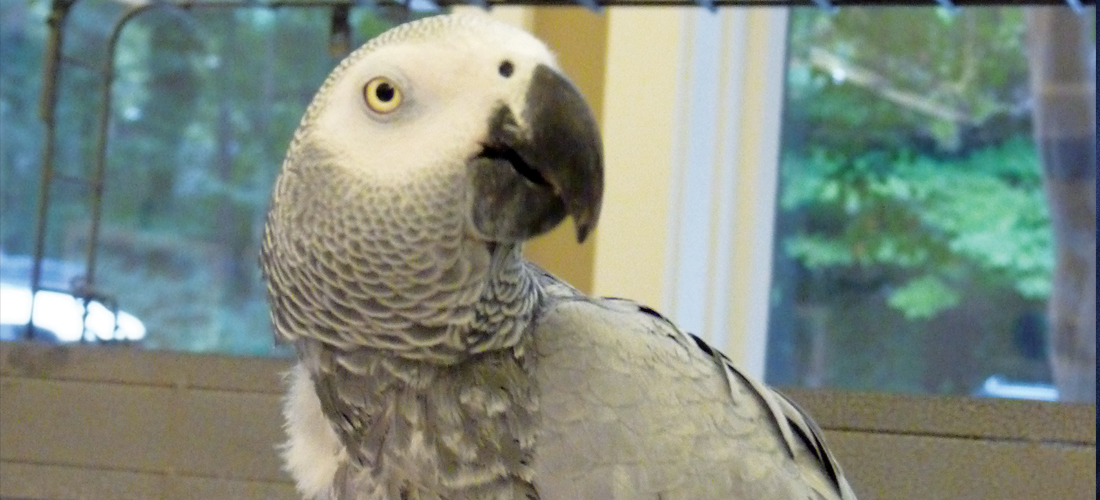
Cagey Character
Winging it with Gandalf the Grey
By Maria Johnson
I’ve always thought that anyone who uses “pansy” as a synonym for wimp knows nothing about pansies, which can be frozen under winter ice and come back swinging in the spring.
In a similar vein, you’d better think twice about the term “bird brain.”
Gandalf is why. I first met the 17-year-old African Grey parrot this past spring when I took our dog, Rio, to the vet.
He caught wind of Gandalf as soon as we stepped into the waiting room at Lawndale Veterinary Hospital, where the foot-long bird perched inside a large cage. Rio was curious. He approached slowly and planted his front paws on the cage to get a closer look.
Gandalf cocked her head and fixed him with a beady black pupil that floated inside a white iris. A sign on her cage warned she could bite, but she kept her distance as they calmly checked each other out.
At the front desk after Rio’s visit, I learned that despite her mostly gray plumage, Gandalf was a colorful character. She was new at being the clinic’s greeter, but she’d already gotten the hang of telling customers “hi” and “bye,” plus a whole lot in between.
She’d commanded one customer — an innocent bloke who’d caused no flap — to “shut up.”
“Did that bird just tell me to shut up?” said the guy, laughing.
“Keep moving,” said Gandalf.
You gotta admire a bird with that kind of comic timing.
On a more recent visit, I met Gandalf’s owner, vet tech Carmen Bowes, who recounted how Gandalf landed in her life. It started last November, when Carmen got a call from friends at the Greensboro Science Center, where she used to work. A zoo volunteer was looking for a new home for her African Grey. The woman and her husband were traveling a lot, and the bird had been chewing her feathers, a sign of stress. The couple hoped to find a loving, long-term home for her, although at the time they believed Gandalf, named after a wizard in Lord of the Rings, was a male. She had never laid an egg and, like other African Greys, had no visible sex organs.
Carmen, a former keeper of penguins at the Science Center, was interested in meeting Gandalf. She had a fairly birdy background and knew that African Greys could live to be 50 or older, that they were endangered in their native Africa, and that they could be, in her words, “temperamental and bitey.”
Sure enough, Gandalf nipped Carmen the first few times she visited. Carmen decided to let Gandalf make the overtures. She also introduced Gandalf to her husband, Drew, who wasn’t really a bird person. Gandalf took a shine to Drew, confirming what her owners had observed: She liked men more than women. Drew liked Gandalf, too, so he and Carmen took her home to their other “children,” three Great Danes and two cats.
Gandalf fit right in. She was sociable and sassy. She corrected the dogs with a sharp “Ah-ah!” She mimicked the microwave: “Bing!” When someone dropped something, she sympathized: “Oops. Sorry!” When night fell, she asked for her cage to be covered: “Gandalf ready to go night-night.” When she didn’t get what she wanted, she sighed loudly. Not only did she copy sounds, she understood context and generated responses that fit the situation.
“It’s like living with a 2- or 3-year-old child,” says Carmen. “She’s extremely smart.”
Gandalf and Drew were birds of a feather. She clung to his hand and recited rap songs with him. She let him dangle her upside. She cuddled against his chest. About a month into the adoption, a white, walnut-size egg appeared on the floor of Gandalf’s cage.
A wizard indeed.
For whatever reason, Gandalf had become fertile, but Carmen and Drew decided not to breed her. They also kept her name because that’s what Gandalf called herself, as in, “You’re a good bird, Gandalf.” With the blessings of her coworkers, Carmen started bringing Gandalf to work. The stimulation would be good for her, Carmen thought, and her antics might entertain the customers.
Gandalf seized the stage. Sometimes, she growled and barked as dogs entered. Other times, she whistled and called, “Come here!” She has been known to make her “sick kitty” sound — a moaning mewl — when people bring in ailing felines. When music plays in the background, she steps and shimmies to the beat. She favors “Uptown Funk” by Bruno Mars and “Happy” by Pharrell Williams.
When delivery trucks back up to the clinic, Gandalf alerts bystanders with the “beeeeep, beeeep, beeeep” of machinery in reverse.
She has pecked a handful who’ve ignored the warning about biting, but most people keep their fingers to themselves and enjoy the interaction. For many customers, stopping to speak to Gandalf is a part of the visit. Kids flock to her. And yes, she warms to men.
Several weeks ago, she flirted with a departing fellow. She preened and chattered. She said “bye” to him four times. She turned to watch him walk across the parking lot.
“She was sad to see him go,” says receptionist Julie Hean. “It was funny because he wasn’t her type.” Big, furry and friendly, like the bearded Drew — that’s Gandalf’s type. Maybe that’s why, when Carmen freed her from her cage recently, she let Rio come close, sniffing. I worried she might take a chunk out of his nose. At least we were already at the vet.
Rio stopped a few inches away. What would happen next? Anticipation was thick. Gandalf read the moment.
A smooch sound filled the gap.
“She blew him a kiss,” said Carmen. OH
To see video of Gandalf dancing, go to O.Henry’s Facebook page. Maria Johnson is a contributing editor of O.Henry. You can reach her at ohenrymaria@gmail.com.





